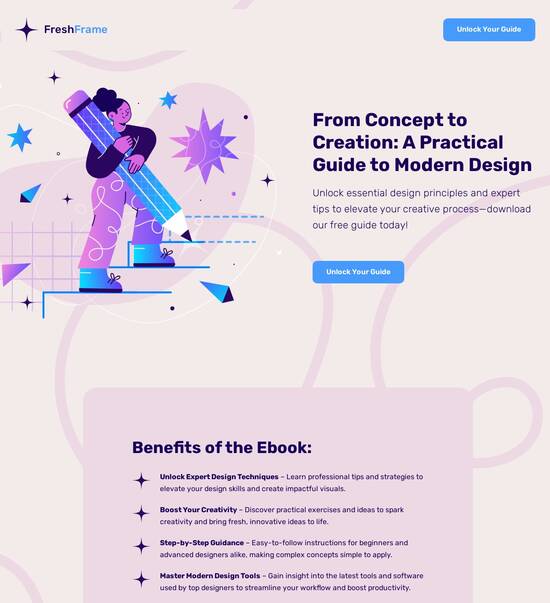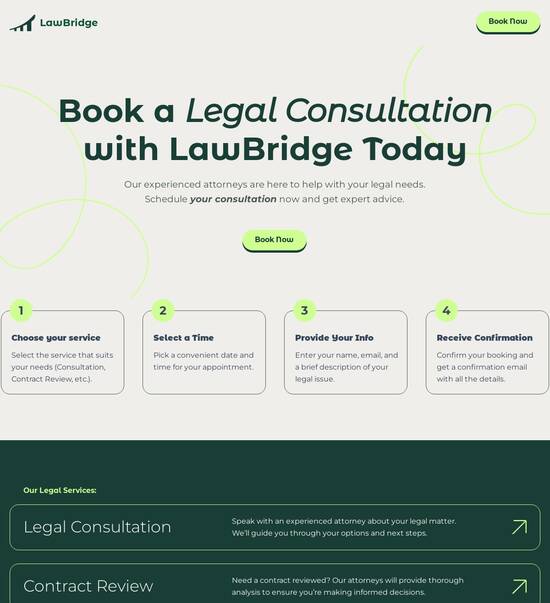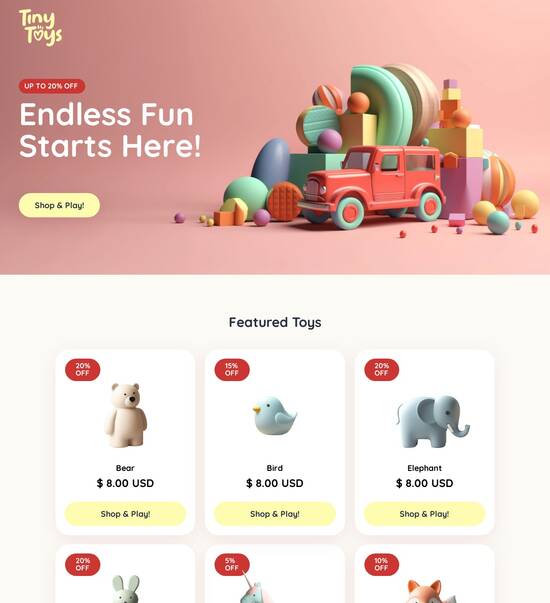
Design Safari-ready 404 error page templates
Explore Similar TemplatesAbout template
Choose the best 404 error page template for Safari
Recommended templates

Easy to build without coding
With the intuitive drag-and-drop builder, anyone on your team can create high-converting pages without any knowledge of code or design. Make enhancements to your landing page with custom widgets using Javascript, HTML/CSS, or third-party scripts.

Multiple layouts for any industry and goal
Select from 500+ landing page layouts built to boost conversions across industry-specific scenarios. Customize them by adjusting fonts, adding images, and generating on-brand content with the AI assistant. Quickly scale with Instablocks® and Global Blocks that you can save, reuse, and update globally.

Loads fast and looks polished on any device
Every template is responsive, which means they present professionally on any device and load blazingly fast with our Thor Render Engine. You can also power them up with Google AMP technology to deliver an unparalleled mobile experience and drive higher conversions.

Robust analytics & experimentation
Get real-time updates and reporting across all your devices, showing the number of visitors, conversions, cost-per-visitor, and cost-per-lead. Launch AI-powered experiments, run A/B tests, and use heatmaps to analyze user behavior, then optimize your landing page to maximize conversions.







Easy to build without coding
With the intuitive drag-and-drop builder, anyone on your team can create high-converting pages without any knowledge of code or design. Make enhancements to your landing page with custom widgets using Javascript, HTML/CSS, or third-party scripts.
Multiple layouts for any industry and goal
Select from 500+ landing page layouts built to boost conversions across industry-specific scenarios. Customize them by adjusting fonts, adding images, and generating on-brand content with the AI assistant. Quickly scale with Instablocks® and Global Blocks that you can save, reuse, and update globally.
Loads fast and looks polished on any device
Every template is responsive, which means they present professionally on any device and load blazingly fast with our Thor Render Engine.
Robust analytics & experimentation
Get real-time updates and reporting across all your devices, showing the number of visitors, conversions, cost-per-visitor, and cost-per-lead. Launch AI-powered experiments, run A/B tests, and use heatmaps to analyze user behavior, then optimize your landing page to maximize conversions.
All the features you need to build lead-generating landing pages
Explore more featuresLearn how to build top-performing landing pages for any goal
FAQs
Leading the way in building high-performing landing pages





A step-by-step guide to using Instapage for optimizing your digital marketing campaigns
Instapage is regarded as the leading platform for creating high-converting landing pages and enhancing conversion rate optimization (CRO). For marketers in the USA across various sectors, such as business services, education, and technology, understanding how to leverage Instapage’s features is vital for maximizing ROI. This guide provides a comprehensive walkthrough on effectively utilizing Instapage to enhance your digital marketing approach.
Overview of Instapage functionalities
Instapage offers marketers a powerful suite of tools designed to optimize landing pages and marketing efforts. With over 100 customizable templates and features tailored for personalization, Instapage empowers users to create landing pages quickly and effectively, addressing diverse audience needs without any coding skills.
- Templates: Choose from 100+ high-converting designs that are ready to deploy.
- Lead Generation Elements: Utilize pre-built elements to capture leads effectively.
- Analytics and Tracking: Access real-time data to monitor performance and conversions.
Building your first landing page
Creating your landing page can be seamlessly executed by following simple steps. Begin by selecting a template that aligns with your campaign goals.
- Select a high-converting template that suits your business objective.
- Customize the template to include relevant brand elements and messaging.
- Set up lead capture forms to maximize conversion opportunities.
Optimizing your landing page for conversions
Optimization is crucial for enhancing page performance and increasing conversions. Instapage offers built-in A/B testing features and heatmaps.
- Use heatmaps to analyze user interaction and improve on-page elements.
- Conduct A/B testing to understand which variations drive better results.
- Implement personalized content through dynamic text replacement to target specific audiences.
Collaboration features for marketing teams
Instapage simplifies collaboration, allowing your team to work efficiently. Share your landing pages with team members for instant feedback.
- Enable real-time edits to streamline updates.
- Share pages securely with external stakeholders for approval.
- Utilize feedback tools to enhance the page creation process.
Mastering these steps will enhance your team's capability to create powerful landing pages that resonate with your audience, resulting in higher conversion rates.
Start leveraging Instapage today to transform your marketing campaigns. With its intuitive features and powerful capabilities, achieving your digital marketing goals is within reach.
People also ask about 404 error page template optimized for Safari
Creating a 404 error page template optimized for Safari
Understanding the 404 error page: Significance and user impact
A 404 error page is returned by a web server when a user tries to access a page that cannot be found. This happens for several reasons, such as broken links, deleted pages, or mistyped URLs. The presence of a 404 error page is crucial as it serves as a last resort to inform users that what they are looking for doesn’t exist. Rather than showing users a blank screen or providing a generic error message, a well-designed 404 page can guide users back to relevant content.
Statistics indicate that a significant percentage of users may abandon a website after encountering a 404 error page. Studies suggest that nearly 70% of users who arrive at a broken link will leave that site rather than navigate further. This highlights the importance of not only creating a functional webpage but also ensuring that an emotional connection remains with the users, even when facing an error.
Only 20% of users will revisit a site after encountering a poor 404 page.
Optimized 404 pages reduce overall bounce rates.
A creative 404 page can improve brand perception and user engagement.
The initial impact of a 404 page can shape a user’s perception of a brand or website. Users may feel frustration or neglect if they don't find useful guidance on the error page. By transforming this moment into an opportunity, web designers can effectively enhance user experience and maintain engagement.
Designing for Safari: Why browser-specific optimization matters
Safari, Apple's web browser, has unique user demographics and features that necessitate tailored design approaches. The browser is known for its emphasis on clean aesthetics and user privacy, appealing predominantly to users within the Apple ecosystem. With a growing user base, ensuring that websites perform optimally on Safari is crucial to retaining visitors who are accustomed to its seamless experience.
Failure to provide a compatible 404 error page could alienate these users, as they may quickly abandon a site that doesn’t deliver a consistent experience. Compatibility across different browsers is essential, but each browser's handling of errors can differ; for example, Safari prioritizes the aesthetics of error display while also suggesting search capabilities. Therefore, understanding Safari's nuances can offer insights into crafting an effective error page.
Safari provides a minimalistic error display that requires additional visual elements to retain users.
User trust can diminish when encountering unoptimized pages on preferred browsers.
Unique features like Safari Reader can be leveraged to enhance content visibility.
Recognizing how Safari interacts with web pages will undoubtedly impact user retention and satisfaction, reiterating the significance of designing for specific user experiences through browser optimization.
Crafting a Safari-optimized 404 error page template
Creating a functional and visually appealing 404 error page template requires thoughtful consideration of its core elements. Key components include an apology message, a navigation menu, and suggestions for alternative content. By defining these core elements, designers will create a user-friendly experience that informs visitors while providing redirection options. This aims to minimize user frustration and encourages continued exploration of the website.
Apology/Error message: A friendly note acknowledging the issue.
Navigation menu: Links to crucial sections of the website.
Search bar: Allowing users to search for what they intended to find.
Suggested links/Popular pages: Redirecting users to relevant content.
An innovative visual design can further enhance user experience. Imagine an outer space scene that serves as a metaphor for exploration and discovery. This theme can be compelling, encouraging users to venture beyond the current error. Utilizing cosmic imagery and vibrant colors creates a memorable ascent from frustration to fascination.
Consider design elements such as the layout, fonts, and colors that reflect both the theme and the brand's overall aesthetic. Additionally, incorporating animations or interactivity can further engage users, making the 404 page a place of curiosity rather than a moment of annoyance.
Content that connects: Effective messaging
A well-crafted error message can soothe frustrated visitors and motivate them to stay. Branding through tone is crucial; a light-hearted and transparent approach can leave a positive impression. Incorporating humor within the messaging can also humanize the experience and present the brand as relatable. For example, engaging visitors with phrases like, 'Looks like you’ve taken a wrong turn on this space adventure!' can evoke a smile and lessen frustration.
Related blog posts: Keep users informed and engaged by linking to similar content.
Current events/promotions: Highlight timely offers or valuable insights.
User-generated content: Showcasing community contributions fosters trust.
Integrating these suggestions increases the likelihood that users will continue exploring. The goal is to keep the dialogue open, thus ensuring the relationship remains intact despite adverse moments. The 404 error page can be a pivotal point for storytelling, allowing brands to communicate and retain their audience even during setbacks.
Enhancing user experience: Guiding visitors beyond the error
A cohesive user experience doesn’t end on a 404 error page. Implementing strategies that redirect users to functional pages is vital in mitigating frustration. For instance, seamlessly guiding them to the homepage or other key sections of the website can transform a negative experience into a beneficial one. An intuitive navigation system can help ensure users don’t feel lost or abandoned, thus maintaining their engagement.
Moreover, developing a unique festival-themed 404 page can draw attention to seasonal offerings or relevant content, keeping the user engaged despite the error. By harnessing imagery that resonates with various festivities, users are more likely to smile rather than scowl at being redirected. In addition, creatively using visuals can make 404 pages feel less like dead ends and more like detours towards delightful exploration.
Analyzing performance: Metrics for success on 404 pages
To ensure the effectiveness of a 404 error page, it’s essential to monitor its performance comprehensively. Key performance indicators (KPIs) can reveal important insights regarding user interactions with the error page, guiding necessary optimizations. Key metrics include engagement rates, bounce rates, and the number of users who successfully navigate away from the error page.
Engagement rate: Measure how many users stay to explore after encountering the error.
Bounce rate: Track how many users leave the website after viewing the 404 page.
Redirects: Analyze how many users clicked links to navigate away from the error.
Utilizing analytics tools enables website owners to better understand user behavior. Heat maps can reveal where users click most often, while A/B testing can illustrate which design elements drive engagement. Adjusting content based on these insights can lead to increased user retention and satisfaction, proving that a thoughtfully designed 404 page can significantly reduce user abandon rates.
Best practices for 404 error pages across devices
In today's multi-device environment, ensuring that a 404 error page is mobile-responsive and tablet-friendly is vital. Responsive design not only enhances accessibility but also promotes user comfort across different devices. A seamless experience translates well from desktop to mobile, minimizing the risk of frustrating users further with poor accessibility.
Test the page on various devices: Ensure consistent performance across screens.
Optimize loading speeds: Long load times can amplify frustration.
Provide localized versions where necessary: Cater to diverse audiences effectively.
Application of A/B testing can further help understand how different layouts and content resonate with users, ultimately shaping a more effective error page that suits a wider audience. A well-designed 404 error page that functions well on multiple devices significantly lowers the disruption caused by the error and ultimately retains user interest.
User feedback and iteration: Emphasizing continuous improvement
User feedback is an invaluable resource for refining 404 error pages. Gathering insights on visitors' experiences can lead to actionable improvements. Methods for collecting feedback include using surveys or direct prompts on the error page. Understanding user sentiments about the design and usability of the 404 page can guide companies in enacting substantial enhancements.
Surveys: Directly ask visitors about their experience on the 404 page.
Feedback forms: Allow users to submit suggestions or comments.
Analytics review: Regularly assess user behavior metrics for improvements.
Encouraging feedback creates a dialogue that can help balance user expectations with design choices. By iterating based on real-time user data, companies can develop error pages that continuously improve, making them not just functional but a pleasure to encounter.
The end of frustration: Creating a 404 page that empowers users
The ultimate goal of a well-designed 404 error page is to facilitate a smooth transition back into the user journey, transforming what could be a frustrating experience into one of empowerment. It’s essential to provide users with valid alternatives that maintain engagement with the website. By treating the error page as an opportunity rather than an obstacle, brands can craft a narrative that keeps users interested even when they initially encounter an error.
Celebrating web engagement despite errors can create a positive ambiance around the brand. Through storytelling elements, such as humorous visuals or engaging content, a relatable approach can resonate with users, showcasing resilience and creativity amidst challenges. In this way, an error page can become a springboard for further user interaction rather than a stopping point.
Conclusion in context: Embracing the inevitable
Errors are an inherent part of the web experience, making it vital to approach them with a strategic mindset. Rather than viewing 404 errors negatively, brands can turn these moments into opportunities by crafting creatively designed error pages that resonate with users. It’s essential to highlight that even when users come across setbacks, their experience can still be nurtured positively.
Ultimately, creating a well-crafted 404 page is about embracing these challenges and utilizing them to build stronger user relationships. Through insightful design, valuable content, and user-oriented messaging, even an error page can become a canvas for engagement, leaving a lasting impact on user perception and brand loyalty.
Ready to skyrocket conversions?
Supercharge your ad campaigns with high-performing landing pages
Get started














